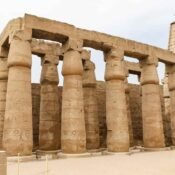
Egyptian pyramids
The Egyptian pyramids, particularly the Great Pyramid of Giza, are among the most magnificent man-made monuments in history. They were constructed when Egypt was one of the world’s richest and most powerful civilizations. Its great size is a reflection of the special position that kings and pharaohs had in predynastic Egyptian society.
The construction of the pyramids peaked towards the end of the 3rd Dynasty and continued until the 4th century AD, while they were constructed from the beginning of the Old Kingdom until the end of the Ptolemaic dynasty (circa 2325 BC). The Egyptian pyramids, which date back more than 4,000 years, are still majestic and provide a window into the nation’s illustrious past.
The Pharaoh in Society of Egypt
The Old Kingdom’s Third and Fourth Dynasties saw Egypt reach new heights of affluence and stability in the economy. Kings held a distinct position in Egyptian society. They are believed to have been chosen by the gods themselves to serve as a sort of middleman between mortals and the gods on earth. It is in everyone’s best interest to keep the king in check. Horus, the falcon god who had previously served as Ra’s guardian, succeeded Ra as ruler.
Under the Third and Fourth Kingdoms of the Old Kingdom, Egypt experienced economic stability and prosperity. The position of king was one of great honour in ancient Egypt. They would be selected by the gods themselves to serve as a sort of middleman between people and the gods on earth. It is in everyone’s best interest to preserve the king’s honour. The new pharaoh was then succeeded by the falcon deity Horus, who is also Ra’s defender.
Djoser Pyramid:
During the early dynastic period (2950 BC), the royal tombs were carved out of rock and covered with flat-roofed rectangular structures known as “mastabas,” which were the forerunners of the pyramids. The first pyramids of Egypt were built in 2630 BC. At Saqqara, a monument honouring King Djoser of the Third Dynasty. Initially a standard mastaba, this pyramid, also known as the “stepped pyramid,” later changed into something more substantial.
Tradition has it that Imhotep, a priest and healer who is honoured as the patron saint of healers, designed the pyramid about 1,400 years later. King Djoser built six stone floors of the pyramid using the Object() [native code] function throughout the course of his 20-year rule (as opposed to burnt bricks like most early tombs). It was the highest building at the time. The complex of courtyards, temples, and shrines that surrounds the stepped pyramid is where Djoser can enjoy the afterlife.
Even though no graves that the dynasty’s successors had planned were carried out (perhaps as a result of King Djoser’s reign), the stepped pyramid was utilized as the norm for royal burials after King Djoser. theirs is rather brief). One of the three tombs at Dashur, the Red Pyramid, was constructed for Sneferu (2613–2589 BC), the first monarch of the 4th Dynasty and the oldest tomb ever constructed in the “actual” world (smooth, non-stepped pyramid). The name of the structure was motivated by the hue of the limestone blocks used to construct the pyramid’s core.
The Great Pyramids of Giza:
The Great Pyramid of Giza, located outside present-day Cairo in the highlands of the West Nile, is the most famous of all pyramids. The only surviving example of the famous seven wonders of the ancient world is the oldest and largest of its three pyramids at Giza, known as the Great Pyramid. It was built for Pharaoh (Greek: Cheops), the second of the eight kings of Pharaoh’s Fourth Dynasty and the successor of Sneferu.
The Pyramid of King Khufu (Cheops):
Little is known about Cheops’ 23-year rule other from the beauty of the pyramids (2589-2566 BC). The pyramid was the tallest in the world at 481.4 feet (147 metres) high and had an average base length of 755.75 feet (230 metres). Next to the Great Pyramid, where her mother, Queen Hetepheres, discovered the empty sarcophagus, are its three lesser pyramids, built for Queen Cheops wifes. Rows of mastaba, which are tombs for the king’s family and the officials who assisted and accompanied him in the afterlife, encircle Cheops’ pyramid.
The Pyramid of King Khafre:
The Central Pyramid of Giza was constructed for Pharaoh Khafre, the son of Khufu (2558-2532 BC). The tomb of Pharaoh Khafre is located inside the Pyramid of Khafre, the second-tallest pyramid at Giza. The Great Sphinx, a limestone guardian monument with a human head and a lion’s body, is a distinctive element incorporated into the Khafre pyramid complex. It was the largest statue in all of antiquity with a length of 240 feet and a height of 66 feeta length of 240 feet and a height of 66 feet, it was the largest statue in all of antiquity. The Great Sphinx itself would be adored throughout the Eighteenth Dynasty (around 1500 BC AD), as a representation of a regional form of Horus. Menkaure, the son of Khafre, had the southernmost pyramid at Giza constructed for him (2532-2503 BC). The shortest of the three pyramids (218 feet tall)it served as a forerunner to the smaller pyramids that would be built during the Fifth and Sixth Dynasty.
Who Built The Pyramids Workmen or Salves?
Contrary to certain popular versions of the narrative that claim slaves or foreigners were employed to build the structures, human bones found nearby imply that employees were made to work when the Nile flooded. create pyramids. This indicates that they are probably Egyptian seasonal farmers. terrain close to the pyramids. More than 2.3 million stone blocks weighing an average of 2.5 tonnes each were cut, transported, and put together to create the Pyramid of Khufu. However, later archaeological investigation suggested that the real number of employees may have been closer to 20,000. Herodotus, an ancient Greek historian, claimed that it took 20 years and 100,000 labourers to complete.
from pyramid to Luxor:
you can have an over night from Cairo to Luxor, so you reach Luxor at sunset or at night, then over night in the hotel and at early morning you can do a hot air balloon flight with Balloon Over Luxor company, then back to your hotel to have breakfast and check out.
your tour will start with visiting valley of the kings, temple of queen Hatshepsut, colossi of Memnon, then have lunch at local restaurant, later visit karnak temple & Luxor temple then go to Airport to fly back to Cairo.
Recent Posts
Luxor day tour: Most Illuminated Temples
Discover Luxury Nile Cruises
Designing the Perfect Itinerary for Your Nile Cruise




